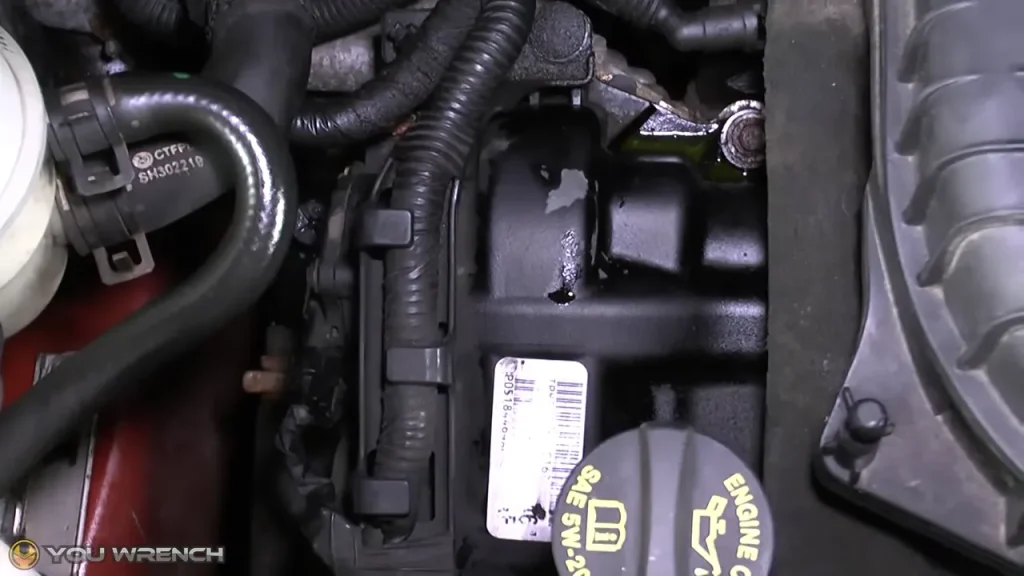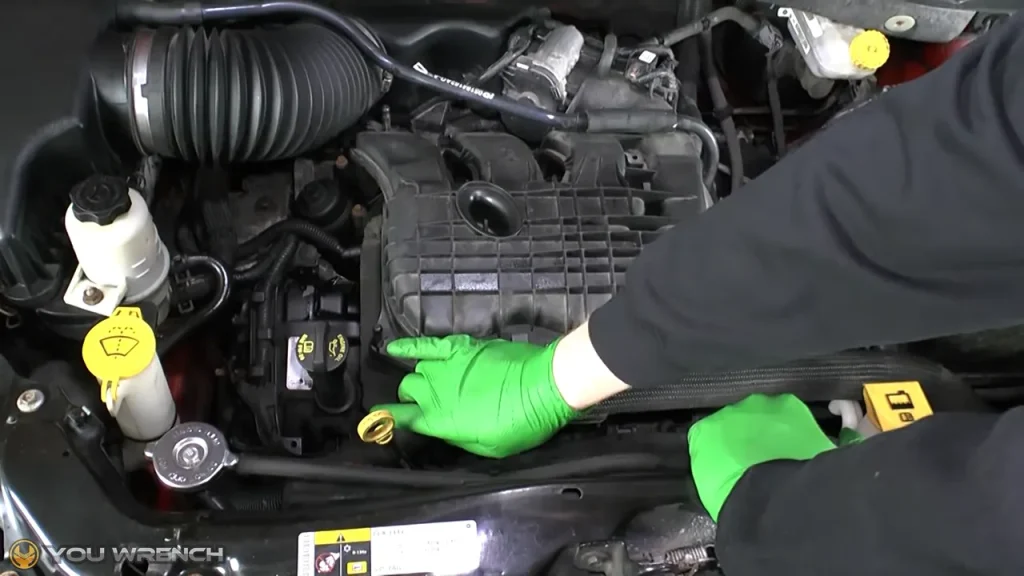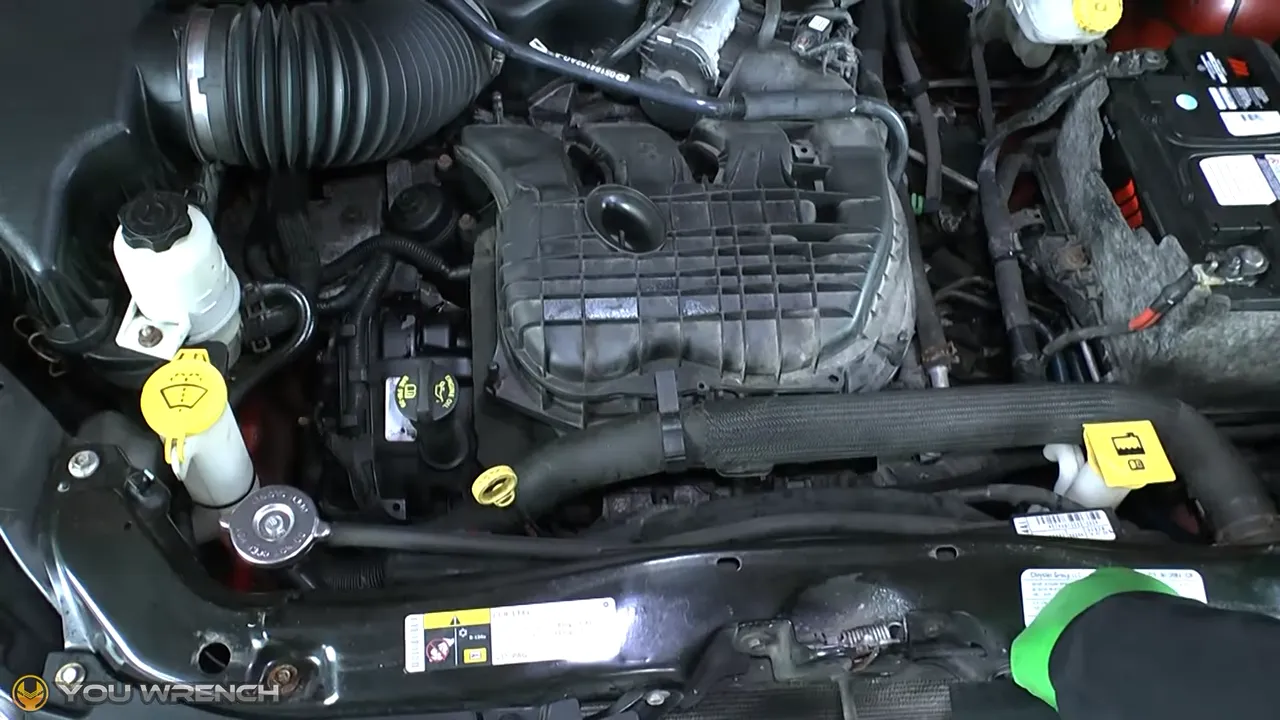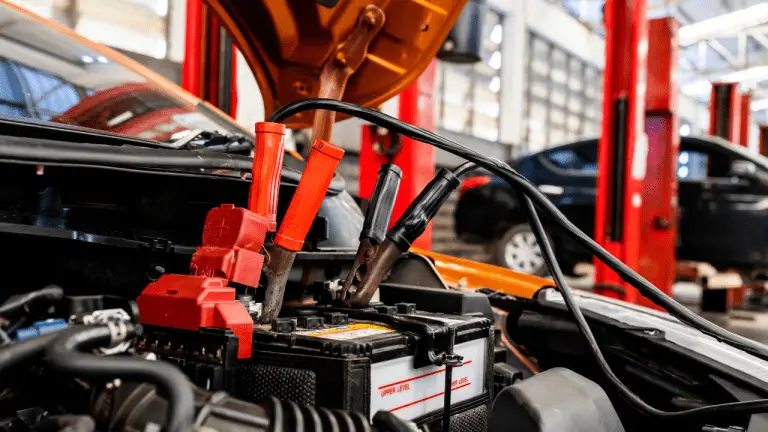How to Unstick a Thermostat in a Car? (Details 2024)
If you suspect that the thermostat in your car is stuck, impeding the proper flow of coolant and potentially causing overheating, there are a few steps you can take to address the issue. Start by turning off the engine and allowing the car to cool down.
Once the engine is cool, locate the thermostat housing, which is often positioned near the engine’s top. Gently tap the thermostat housing with a wrench or a rubber mallet. This tapping can sometimes dislodge any debris or sediment that may be causing the thermostat to stick. If tapping doesn’t resolve the issue, you may need to replace the thermostat altogether.
What Causes Thermostat to Stick?
A sticking thermostat can be caused by various factors that hinder its proper operation in regulating the engine’s temperature. Here are common reasons why a thermostat may stick:
- The Coolant Level Might Be Low: Low coolant levels can lead to air pockets in the cooling system, affecting the thermostat’s ability to function correctly. Maintaining the proper coolant level is essential for the thermostat to open and close as needed.
- Dirty or Old Engine Oil: Engine oil that has become dirty or contaminated can impact the thermostat’s performance. Over time, debris in the oil can accumulate and affect the thermostat’s movement, causing it to stick in the closed or open position.
- Coolant that Needs to be Replaced: Old or degraded coolant can result in the formation of sludge or sediment in the cooling system. This buildup can interfere with the thermostat’s movement, causing it to stick and impede the flow of coolant.
- Build-up of Scale or Deposits on the Thermostat: Scale or deposits can accumulate on the thermostat over time, hindering its proper operation. This buildup can be a result of minerals in the coolant or impurities in the water used in the cooling system.
- Failed Cooling Fan: If the engine cooling fan fails to operate correctly, the temperature in the cooling system can rise excessively. This elevated temperature may cause the thermostat to stick in the closed position, preventing coolant flow and leading to overheating.
Can You Drive With a Bad Thermostat?
Driving with a bad thermostat is not advisable and can lead to potential engine problems and overheating. The thermostat plays a crucial role in regulating the engine’s temperature by controlling the flow of coolant.
If the thermostat is stuck closed, it prevents the coolant from circulating through the engine, resulting in overheating. Conversely, if the thermostat is stuck open, the engine may take longer to reach its optimal operating temperature, leading to decreased fuel efficiency and increased wear.
Continuous driving with a malfunctioning thermostat can cause severe engine damage, such as warped cylinder heads or a blown head gasket. If you suspect issues with your thermostat, it’s essential to address the problem promptly by having it inspected and replaced by a qualified mechanic. Regular maintenance and addressing cooling system issues can help prevent more extensive and costly engine damage in the long run.
Can a Car Overheat Without a Thermostat?
Yes, a car can still overheat even without a thermostat, although the likelihood of overheating is higher with a malfunctioning or removed thermostat. The thermostat plays a critical role in regulating the flow of coolant through the engine, allowing it to reach and maintain the optimal operating temperature.
If the thermostat is stuck closed or removed entirely, it prevents or restricts the flow of coolant, leading to inadequate cooling of the engine. This restriction can result in overheating, especially during periods of heavy load or extended driving.
While removing the thermostat might seem like a solution to prevent overheating, it is not recommended as it disrupts the engine’s normal operating temperature and can lead to various issues, including decreased fuel efficiency and increased engine wear.
If your car is experiencing overheating problems, it’s essential to have the cooling system inspected by a qualified mechanic to identify and address the root cause of the issue.

Can a Stuck Thermostat Cause Heater Not to Work?
Yes, a stuck thermostat can cause the heater not to work properly in a car. The thermostat regulates the flow of coolant through the engine to maintain an optimal operating temperature. When the thermostat is stuck in the closed position, it restricts the flow of coolant, preventing it from reaching the heater core, which is responsible for providing warm air to the interior of the vehicle.
As a result, the heater may blow cold air or not produce sufficient warmth. A malfunctioning thermostat disrupts the normal circulation of coolant, affecting both the engine’s temperature and the ability of the heater to function efficiently.
If you notice issues with your car’s heater, such as inconsistent or no heat, it’s advisable to have the thermostat inspected and, if necessary, replaced by a qualified mechanic to restore proper functionality to both the engine and the heating system.
How Much Does It Cost to Fix a Stuck Open Thermostat?
The cost to fix a stuck-open thermostat can vary based on several factors, including the make and model of your vehicle, labor rates in your area, and whether you choose to use an original equipment manufacturer (OEM) or aftermarket thermostat.
On average, the cost of a thermostat itself ranges from $20 to $50. However, the total cost of the repair will also include labor charges, which typically range from $100 to $200 or more, depending on the complexity of the thermostat replacement and the hourly rates of the mechanic.
If other components of the cooling system are found to be damaged or need attention, there may be additional costs. To get an accurate estimate for your specific vehicle, it’s recommended to consult with local auto repair shops or mechanics who can provide a detailed breakdown of the costs involved in fixing a stuck-open thermostat.
What Happens If the Thermostat Doesn’t Open?
If the thermostat fails to open, it disrupts the normal flow of coolant through the engine cooling system, leading to several potential issues. The thermostat is designed to remain closed when the engine is cold, allowing it to warm up quickly.
Once the engine reaches the optimal operating temperature, the thermostat should open, allowing coolant to circulate and regulate the engine temperature. If the thermostat remains closed or is stuck in the closed position, the engine can overheat.
Overheating can result in serious engine damage, such as warped cylinder heads or a blown head gasket. Additionally, the lack of coolant circulation may lead to inefficient fuel combustion, reduced fuel efficiency, and increased emissions.
It’s crucial to address a thermostat that doesn’t open promptly. Replacing the thermostat and ensuring the proper functioning of the cooling system is essential to prevent overheating and maintain the overall health and performance of the engine.

How Can You Prevent a Stuck Open Thermostat?
Preventing a stuck-open thermostat involves regular maintenance and attentive care of your vehicle’s cooling system. Here are some measures to help avoid a stuck-open thermostat:
- Coolant Inspections: Regularly check the coolant level and condition. Low coolant levels or contaminated coolant can affect the thermostat’s performance.
- Routine Flushing: Periodically flush the cooling system to remove any accumulated debris or contaminants. Flushing helps maintain the efficiency of the thermostat and prevents clogs.
- Quality Coolant: Use high-quality coolant recommended by the vehicle manufacturer. Quality coolant contains additives that prevent corrosion and maintain the proper functioning of the thermostat.
- Scheduled Maintenance: Adhere to the manufacturer’s recommended maintenance schedule. Regular inspections by a qualified mechanic can detect potential thermostat issues early on and prevent them from developing into more significant problems.
- Temperature Gauge Monitoring: Keep an eye on the vehicle’s temperature gauge. If you notice consistent overheating or unusual temperature fluctuations, have the cooling system inspected promptly.
- Timely Thermostat Replacement: If your vehicle has been in service for an extended period, consider replacing the thermostat as part of preventive maintenance. Thermostats have a lifespan, and proactively replacing them can prevent malfunctions.
- Proper Warm-Up: Allow your engine to warm up adequately before driving, especially in cold weather. This helps ensure that the thermostat opens and coolant circulates as intended.
Can a Thermostat Be Repaired?
In most cases, a thermostat cannot be repaired and is typically replaced if it malfunctions. Thermostats are relatively simple mechanical devices with a wax-filled element that expands and contracts in response to temperature changes, allowing or blocking the flow of coolant through the engine.
When a thermostat fails, it is often due to internal issues, such as corrosion, wear, or a loss of calibration. Attempting to repair a thermostat may not be practical or cost-effective.
Instead, the recommended course of action is to replace the thermostat. Thermostats are relatively affordable components, and replacing a malfunctioning thermostat is a routine maintenance procedure.
It ensures the proper functioning of the engine cooling system and helps prevent issues such as overheating or inefficient fuel combustion. When replacing a thermostat, it’s advisable to use a quality replacement part and follow the manufacturer’s specifications to ensure optimal performance and longevity.
If you suspect thermostat issues or are experiencing problems with your vehicle’s cooling system, consulting with a qualified mechanic for proper diagnosis and replacement is the best approach.
How Do I Know If My Thermostat Is Stuck in My Car?
Several symptoms can indicate that your car’s thermostat is stuck or malfunctioning. One common sign is the engine overheating. If the thermostat is stuck closed, it restricts the flow of coolant, preventing it from reaching the engine.
As a result, the engine temperature rises, leading to overheating. Conversely, if the thermostat is stuck open, the engine may take longer to reach its optimal operating temperature, resulting in reduced fuel efficiency and poor performance.
Other signs of a stuck thermostat include inconsistent heater performance, where the heater may blow cold air or fail to produce sufficient warmth. Additionally, monitoring the temperature gauge on your dashboard can provide insights; if it remains abnormally high or low, it may indicate thermostat issues.
If you observe any of these symptoms, it’s advisable to have your vehicle inspected by a qualified mechanic to diagnose and address the thermostat problem promptly.
What Happens When a Thermostat Is Stuck Closed?
When a thermostat is stuck closed, it restricts the flow of coolant through the engine, leading to several potential issues. The thermostat’s primary function is to regulate the engine’s temperature by allowing coolant to circulate once the engine reaches a certain temperature.
However, when the thermostat is stuck in the closed position, coolant is blocked from entering the engine, causing it to overheat. Overheating can result in severe engine damage, such as warped cylinder heads, a blown head gasket, or damage to other components.
As the engine temperature rises, the vehicle’s performance may suffer, leading to reduced fuel efficiency and power. Additionally, a closed thermostat affects the proper functioning of the heater, causing it to blow cold air or insufficient warmth into the interior of the car.
Monitoring the temperature gauge on the dashboard can provide an early indication of potential thermostat issues. If you suspect a stuck-closed thermostat, it is crucial to address the problem promptly by having the thermostat inspected and replaced by a qualified mechanic to prevent further damage to the engine and ensure the proper operation of the cooling system.

Can You Drive With a Thermostat Stuck Open?
While it is technically possible to drive with a thermostat stuck open, it is not advisable for the long-term health of your vehicle. When a thermostat is stuck open, it allows a continuous flow of coolant through the engine, which can result in the engine taking longer to reach its optimal operating temperature. This can lead to decreased fuel efficiency, increased emissions, and potential performance issues.
While the engine may not overheat with a thermostat stuck open, it can lead to suboptimal combustion, reduced engine efficiency, and increased wear over time. Additionally, the heater in the car may not function as efficiently, and the engine may not achieve peak performance.
If you suspect that your thermostat is stuck open, it is recommended to have it inspected and, if necessary, replaced by a qualified mechanic. Proper engine temperature regulation is crucial for optimal performance, fuel efficiency, and the overall longevity of your vehicle. Addressing thermostat issues promptly can help maintain your engine’s health and prevent potential complications down the road.
Can You Drive a Car Without a Thermostat?
Technically, you can drive a car without a thermostat, but it is not recommended for sustained use. The thermostat plays a crucial role in regulating the engine’s temperature by controlling the flow of coolant. Without a thermostat, the engine may take longer to reach its optimal operating temperature, leading to reduced fuel efficiency, increased emissions, and potential performance issues.
Additionally, the absence of a thermostat can affect the heater’s efficiency in the interior of the car, causing it to blow insufficient warmth. While removing the thermostat may seem like a temporary solution to prevent overheating, it disrupts the engine’s normal operating temperature and can lead to various problems.
It’s important to note that modern engines are designed to operate within specific temperature ranges, and removing the thermostat can impact their performance and efficiency. If you suspect thermostat issues or are tempted to drive without one, it is advisable to have your vehicle inspected by a qualified mechanic. They can provide proper guidance on whether a thermostat replacement is necessary and ensure your engine operates optimally.
How Do I Know If My Thermostat Is Stuck Open or Closed?
Determining whether your thermostat is stuck open or closed involves observing the behavior of your vehicle’s engine and cooling system. If the thermostat is stuck closed, it restricts the flow of coolant, causing the engine to overheat.
Signs of a stuck-closed thermostat include rapid or consistent overheating, a temperature gauge reading well above normal, and potential steam or coolant leaks. On the other hand, if the thermostat is stuck open, it allows a continuous flow of coolant, leading to slower engine warm-up, reduced fuel efficiency, and insufficient heating in the interior.
In this case, the temperature gauge may show lower-than-normal readings. Additionally, if you experience poor fuel efficiency, a lack of cabin heat, or slow warm-up times, it could indicate a thermostat stuck open.
If you observe any of these symptoms, it’s advisable to have your vehicle inspected by a qualified mechanic. They can diagnose the issue and recommend the appropriate repairs, which may involve replacing the thermostat to restore proper engine temperature regulation.
Can a Stuck Thermostat Cause Coolant Loss?
A stuck thermostat itself may not directly cause coolant loss, but it can contribute to conditions that lead to a loss of coolant. When a thermostat is stuck closed, it restricts the flow of coolant through the engine, causing it to overheat.
Overheating can result in the expansion of coolant and pressure within the cooling system, leading to potential leaks. The increased pressure may cause hoses, gaskets, or radiator components to weaken over time, contributing to coolant loss.
Furthermore, if the engine overheats consistently due to a stuck thermostat, it can lead to more severe issues such as damage to the radiator, hoses, or the head gasket—all of which can result in coolant leaks.
It’s important to address a stuck thermostat promptly to prevent overheating, subsequent coolant loss, and potential damage to the engine components. If you suspect thermostat issues or experience coolant loss, it is advisable to have your vehicle inspected by a qualified mechanic to identify and address the root cause of the problem.
FAQ:
Can I unstick a thermostat myself?
Yes, in some cases, you can attempt to unstick a thermostat. However, it’s essential to exercise caution, and if you’re not comfortable with car maintenance, it’s recommended to consult a professional mechanic.
What are the signs of a stuck thermostat?
Signs include engine overheating, inconsistent heater performance, and unusual temperature gauge readings. If you observe these symptoms, your thermostat may be stuck.
Can tapping the thermostat housing help unstick it?
Yes, gently tapping the thermostat housing with a wrench or mallet can sometimes dislodge debris and help the thermostat move freely.
How do I locate the thermostat in my car?
The thermostat is typically located near the engine’s top, connected to the upper radiator hose. Consult your vehicle’s manual for specific location details.
Can low coolant levels cause a thermostat to stick?
Low coolant levels can contribute to thermostat issues, as air pockets in the cooling system may affect its proper functioning.
Is it safe to drive with a stuck thermostat?
Driving with a stuck thermostat is not recommended, as it can lead to engine overheating and potential damage. It’s advisable to address the issue promptly.
Can a thermostat become stuck due to old engine oil?
Yes, contaminated or old engine oil can contribute to thermostat problems. Regular oil changes can help prevent such issues.
What should I do if tapping doesn’t unstick the thermostat?
If tapping doesn’t work, it’s best to consult a professional mechanic for a thorough inspection and potential replacement of the thermostat.
Can I prevent thermostat issues through regular maintenance?
Yes, regular maintenance, including coolant checks and flushes, can help prevent thermostat problems and ensure the proper functioning of the cooling system.
How often should I replace my thermostat?
Thermostats generally have a lifespan of several years. It’s recommended to replace them as part of routine maintenance, or if you notice signs of malfunction. Consult your vehicle’s manual for specific recommendations.
- Why Are My Car Headlights Not Bright Enough? - May 9, 2024
- How Long Can You Drive With An EVAP Leak? - May 9, 2024
- What Does B Stand for in a Car? [Full Guide] - May 9, 2024


![Key Turns But Won’t Unlock Car Door [Reasons and Fixes]](https://automhelp.com/wp-content/uploads/2023/07/Unlock-Car-Door-768x461.png)

![Homemade Traction Mats [Unlock Your Vehicle’s Grip]](https://automhelp.com/wp-content/uploads/2023/07/Homemade-Traction-Mats-768x461.png)
